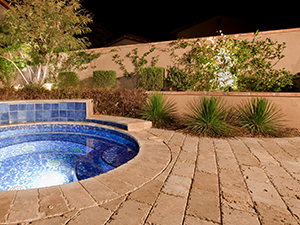The castle-like, serene palette limestone offers makes it a popular choice for homeowners in renovation projects or new construction. This article provides valuable information for anyone considering having limestone installed, as well as anyone with an existing installation. Read on to learn where limestone works best, why limestone is not suitable for wet areas, and how to care for limestone.
Limestone: Suitable for Many Applications
Limestone is an organic sedimentary rock that forms from the accumulation of shell, coral, algal, and fecal debris — a stone of choice for many applications such as interior flooring or walls, fireplace surrounds, backsplashes, in living rooms and recreation rooms, and more. There are many different types of limestone. One of the most popular is travertine, which is often used in exterior installations, such as pool decks or hot tub surrounds.
Most types of limestone can safely be used anywhere that it will not be exposed to excessive amounts of water. Certain types of limestone can be used for kitchen countertops or bathroom vanities, but like almost any natural stone, limestone is susceptible to etching, scratching, and staining. With proper care and periodic professional attention, it can stay looking great indefinitely. Reputable suppliers, fabricators, and installers know where various types of limestone have been installed with great success and positive feedback from owners.
About Limestone in Wet Areas
Stone and tile professionals have noticed problems with limestone installations in showers and other areas that get excessive water exposure, such as staining and deterioration, or in some cases, complete disintegration of the stone. Unfortunately, the blame for problems is often misplaced on suppliers, fabricators, or installers, even though the material is sound and has been installed within industry guidelines.
Here are a few reasons why:
- Iron. Limestone contains iron and other minerals that can oxidize and cause stains that worsen over time. Since iron is part of the mineral makeup of the stone, these stains can be impossible to remove.
- Porosity. Limestone, even when sealed, is typically very porous. Water enters the pores of the stone and reacts with the setting bed, which contains salts. When the limestone dries, the salts recrystallize, causing pressure that can result in the stone spalling, that is, peeling, flaking, or breaking on the surface of the stone. In steam showers, water vapors can enter very tiny pores that liquid water cannot. The steam then condenses in the pores causing the stone to deteriorate.
- Solubility. Limestone contains water-soluble materials, such as calcium carbonate and organic matter. When the water-soluble materials in limestone are constantly exposed to water, the stone can dissolve or disintegrate.
The Natural Stone Institute, the leading trade association in the industry, has a system for designating the soundness of a stone. It recommends that only class A and B stones be used in interior wet areas. Limestone falls into a C class, at best. Many stone types fall into the D classification. For more info on this classification system go to The Natural Stone Institutes website at https://www.naturalstoneinstitute.org/.
In a nutshell, it is not a good idea to use limestone in wet areas.
Let’s Look at Water
One may question the idea that limestone is suitable for areas that do not get excessive water exposure given the fact that limestone is often used for exterior installations without having any issues. This is true, but there is a big difference between the amount of water used in a bathroom shower and the amount of rain on an exterior installation. A bathroom shower, on average, produces over 8,000 inches of water per year. To put this in perspective, the rainiest area on earth is in China, which has 321 inches of rain per year. A shower has over 26 times that amount. That is a lot of water!
Don’t Replace Your Limestone!
If your limestone is already installed and you are having problems, don’t replace it! Most limestone problems can be resolved with professional stone restoration and repair. For example, if your limestone has a highly polished finish, you may opt to switch to a honed finish, which requires less maintenance. Limestone can be professionally cleaned for a fresh, clean look, and sealed to inhibit staining. Etches, scratches, and dullness can be virtually erased with professional honing and polishing. For regular day-to-day care, use a stone-safe, neutral cleaner, and follow the care instructions in our free, downloadable Stone and Tile Care Guide. Contact us for answers to your limestone questions and specific recommendations for caring for your limestone.
This article is one of a series of articles written and published on behalf of Surface Care PRO Partners.
